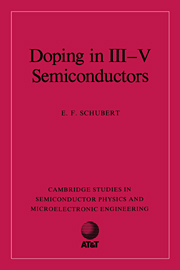Book contents
- Frontmatter
- Contents
- Foreword
- Preface
- List of symbols
- Introduction
- 1 Shallow impurities
- 2 Phenomenology of deep levels
- 3 Semiconductor statistics
- 4 Growth technologies
- 5 Doping with elemental sources
- 6 Gaseous doping sources
- 7 Impurity characteristics
- 8 Redistribution of impurities
- 9 Deep centers
- 10 Doping in heterostructures, quantum wells, and superlattices
- 11 Delta doping
- 12 Characterization techniques
- Appendix A Properties of III–V semiconductors
- Appendix B Constants and conversions
- References
- Index
6 - Gaseous doping sources
Published online by Cambridge University Press: 05 October 2010
- Frontmatter
- Contents
- Foreword
- Preface
- List of symbols
- Introduction
- 1 Shallow impurities
- 2 Phenomenology of deep levels
- 3 Semiconductor statistics
- 4 Growth technologies
- 5 Doping with elemental sources
- 6 Gaseous doping sources
- 7 Impurity characteristics
- 8 Redistribution of impurities
- 9 Deep centers
- 10 Doping in heterostructures, quantum wells, and superlattices
- 11 Delta doping
- 12 Characterization techniques
- Appendix A Properties of III–V semiconductors
- Appendix B Constants and conversions
- References
- Index
Summary
Elemental impurities cannot be used as doping sources in vapor-phase epitaxial growth systems because such impurities would assume the ambient temperature in the reactor and condense on the reactor walls. Vapor-phase epitaxial (VPE) growth techniques therefore require gaseous doping compounds, i.e. chemical gases transporting the doping impurity. Such gaseous doping compounds are called doping precursors and are mandatory for growth techniques with a viscous gas flow such as VPE. Growth techniques with molecular flow can employ either elemental doping sources or doping precursors. Chemical-beam epitaxy (CBE) frequently employs gaseous doping compounds. The use of precursors in CBE is motivated by parasitic chemical reactions between the organometallic sources used for group-III elements and elemental doping sources which result in a degradation in elemental source purity (see Sect. 6.1). Thus the two techniques, VPE and CBE, use doping precursors for different reasons.
The use of non-elemental chemical precursors allows a wide selection of chemicals. The most obvious requirement for these chemicals are (i) a sufficient vapor pressure at room temperature (ii) thermal decomposition of the chemical at the growth temperature, and (iii) no parasitic chemical reactions before and after thermal decomposition. These requirements can be satisfied by either inorganic precursors, e.g. silane or disilane, or organometallic precursors, e.g. dimethylzinc (DMZn).
- Type
- Chapter
- Information
- Doping in III-V Semiconductors , pp. 208 - 247Publisher: Cambridge University PressPrint publication year: 1993



